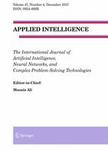版权所有:内蒙古大学图书馆 技术提供:维普资讯• 智图
内蒙古自治区呼和浩特市赛罕区大学西街235号 邮编: 010021

作者机构:Changsha Univ Sci & Technol Sch Comp & Commun Engn Changsha 410114 Hunan Peoples R China Changsha Univ Sci & Technol Hunan Prov Key Lab Intelligent Proc Big Data Tran Changsha 410114 Hunan Peoples R China
出 版 物:《APPLIED INTELLIGENCE》 (应用智能)
年 卷 期:2022年第52卷第1期
页 面:282-294页
核心收录:
学科分类:08[工学] 0812[工学-计算机科学与技术(可授工学、理学学位)]
基 金:National Natural Science Foundation of China [61972056, 61402053] Natural Science Foundation of Hunan Province of China [2020JJ4623] Scientific Research Fund of Hunan Provincial Education Department [17A007, 19C0028, 19B005] Junior Faculty Development Program Project of Changsha University of Science and Technology [2019QJCZ011] "Double First-class" International Cooperation and Development Scientific Research Project of Changsha University of Science and Technology [2019IC34] Practical Innovation and Entrepreneurship Ability Improvement Plan for Professional Degree Postgraduate of Changsha University of Science and Technology [SJCX202072] Postgraduate Training Innovation Base Construction Project of Hunan Province [2019-248-51, 2020-172-48]
主 题:Recommender systems Trust relationship User similarity Social networks Expert user
摘 要:The recommendation system has become the primary tool used by many Internet application platforms to solve the problem of information overload, and it faces issues such as data sparsity, cold start, and scalability. At present, most social recommendation algorithms only consider the influence of the trust relationship on the user s feature vector, which indirectly affects the predicted rating, or consider directly trusting friends as neighbor users, which directly affects the predicted rating, but does not consider the direct influence and indirect combining influences to make rating predictions. Therefore, this paper proposes a collaborative filtering recommendation algorithm (ETBRec), which not only considers the trust difference between users but also proposes the definition of experts and considers the direct impact of expert users on prediction ratings and the trustees indirect impact of ratings. Among them, the trust difference is realized through trust metrics, including direct trust metrics and indirect trust metrics;the selection of expert users takes into account the user s degree of trust and user rating attitude;experimental comparisons with various social recommendation algorithms and related recommendation algorithms on the Ciao and Douban datasets. The experimental results show that the ETBRec algorithm performs better on some evaluation indexes such as mean absolute error (MAE) and root mean squared error (RMSE).